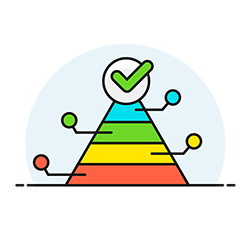31st July, 2025
5 Best Risk Assessment Control Measures With Examples
Control measures are the things you put in place to reduce risk and prevent harm. A successful risk assessment must check existing controls, and consider if you need to do more. In this blog post, we look at the five best risk assessment control measures (with examples), and in which order you should apply them.

A key question for any risk assessment is, how exactly will you control the risks? After all, a risk assessment isn't just a list of the risks. It's an assessment. You are assessing the risk and deciding whether or not it is safe enough to proceed.
Once you have spotted the hazards involved and calculated the risks, you now need to get those risks under control.
A successful risk assessment should check the existing precautions you have in place, and then decide if you need more to prevent harm.
The things you do to reduce the risk are known as control measures. You'll decide on these precautions during step 3 of the 5 steps to risk assessment.

Control measures are needed in risk assessment because the purpose of writing a risk assessment is to protect people.
Do you know the 5 types of risk assessment, and when to use them?
What good is assessing risk if you don't reduce it? And what's the point of a risk assessment if it doesn't make the job safe?
What are control measures in risk assessment?
Control measures are the things you put in place to reduce risk and prevent harm.
Control measures may include one or a mixture of:
- Removal
- Rules
- Procedures
- Equipment
- Exclusions
- Training
- Supervision
- Limitations
- Preventions
- Methods
- Arrangements
There are lots of control measures available. If you tell your team to carry out a task wearing goggles to protect their eyes, that's a control measure. If you send staff on a training course to understand how to do something safely, that's a control measure. If you provide an item of equipment that makes the task safer, that's also a control measure.

Elimination is the best control measure you can use. Remove the risk, and you eliminate the chance of harm. Of course, this is the best control measure, because you eliminate the risk entirely - no risk, no danger, no chance of harm!
Now we know the best control measure, can you use this control for every risk and be the safest business in the world?
Unfortunately, it doesn't quite work like that.
While in theory, it may be possible to eliminate every risk. In practice, this would mean you and your team sitting in a padded room, away from any tools or equipment and not getting any work done. Great for safety, but not so great for your business.
What elimination is actually about, is eliminating those risks that are unnecessary. For example, working at height creates a high level of risk, so if instead, you can do the work from ground level (e.g. using extendable poles or raising and lowering equipment) then you have eliminated the risk of working at height.
What about when you can't eliminate a risk? What if the work has to get done at roof height and there is no getting around it?
Enter, the hierarchy of risk control.

The hierarchy of controls is simply a list of the best control measures, in order of priority. For example, item number 1 in the list (which should now be no surprise - it's elimination) is the best and should be considered first before moving to item number 2.
Here are the 5 best risk assessment control measures:
1. Elimination
We have already discussed this earlier on in this post, and elimination should always be the first control measure you consider. It's at the top of the hierarchy of risk control for a reason!
Ask yourself, can this risk be removed entirely from this activity? If the answer is yes, you can eliminate the risk.

Examples of elimination:
- Use extendable tools to eliminate work at height
- Materials delivered already cut to size to remove the use of blades
- Cordless equipment to get rid of trailing cables
2. Substitution
Substitution is the second-best control measure you could use. Maybe the risk cannot be removed entirely (as is often the case), but could it be reduced by replacing the material, substance or process with something less dangerous?
If you can switch to a lower-risk alternative, you can use substitution to make your work safer.

Examples of substitution:
- Replacing ladders with tower scaffolds
- Substituting a hazardous chemical with a safer alternative
- Changing high-level vibrating equipment with newer equipment with less vibration exposure
3. Engineering controls
The third option on our list is engineering controls - usually fixed temporary, or permanent controls. Engineering controls could be collective (protecting all workers eg. edge protection for work at height) or individual (protecting a single user eg. anchor points for connecting via lanyard).
Give priority to measures which protect collectively over individual measures, because they protect multiple people and often require no action from the user to activate.

Examples of engineering controls:
- Extraction machines to remove hazardous dust or fumes from the air
- Enclosing dangerous items of machinery or moving parts
- Installing guard rails to fall hazards
4. Administrative controls
At number four, we have administrative controls. While this type of control is lower in priority than the previous items on our list, it will often be an essential part of your control measures. These are the rules and systems you put in place to carry out the work safely.
What are the procedures you need to do your work without anyone getting hurt?

Examples of administrative controls:
- Limiting the use of vibrating equipment below exposure action values
- Banning work at height and lifting operations in bad weather
- Enforcing a one-way traffic system on the site
5. Personal protective clothing and equipment
Last, but not least on our list, is personal protective clothing and equipment (PPE).
PPE is the last line of defence against a hazard, so while it shouldn't be your first choice when controlling risks, it can give the wearer added protection for any remaining level of risk, or if other controls fail.

Examples of PPE:
- Use of ear defenders when using noisy equipment
- Harnesses and lanyards where you can't eliminate the risk of falls completely
- Hard hats where there may be falls of tools or materials overhead
Selecting the best controls for your risk assessment
You don't have to pick just one control for each risk from the top 5. Your risk assessment will probably identify several different risks, and it is unlikely they can all be removed completely. There is often some level of residual risk remaining.
If you can't eliminate risk, then often, the best way to control the risk will be through a combination of the other types of control measures. These controls help to bring the remaining risk down as low as is reasonably practicable (ALARP).
For example, you might replace a toxic chemical with one that is no longer toxic. But the new chemical might still be dangerous. You could then implement engineering controls (secure storage area, fume extraction), administrative controls (training and job rotation to limit exposure) and PPE (for example gloves, RPE, and googles) for its use.
Remember to make sure all the controls work well together, are detailed in your risk assessment, communicated to your team, and are regularly reviewed and maintained to remain effective.
And remember while PPE is often needed and is the most visual control measure, it's the last line of defence and shouldn't be your primary control measure. Train workers in the function and limitation of each PPE item they use and make sure multiple PPE items need to work well together.
Need help writing your risk assessments? Speed up your paperwork with how to write a risk assessment in 5 minutes, and use the free blank risk assessment template to get started.
This article was written by Emma at HASpod. Emma has over 10 years experience in health and safety and BSc (Hons) Construction Management. She is NEBOSH qualified and Tech IOSH.
Need Health and Safety Documents?
Search hundreds of health and safety documents ready to edit and download for your business.
Health & Safety DocumentsRecent posts like this...

What Is SSIP Accreditation?
SSIP is a term that has popped up in health and safety in recent years and often appears in pre-qualification questionnaires and company literature. But what is SSIP? Is SSIP another assessment you need to go through? If SSIP is a new requirement, how do you join or become a member?
Read Post
What Is A Method Statement And Why Are They Used In Construction?
You will find method statements on nearly every construction project. They are often used with risk assessments for the tasks and activities carried out during the project. But what is a method statement document, and why are they used in construction?
Read Post
The Purpose Of Writing Method Statements And Risk Assessments
Why do businesses create method statements and risk assessments? It might seem like you are just going through the motions to satisfy legal and client demands, but are there any other benefits? If you're wondering if these documents are just another box to tick, keep reading...
Read Post